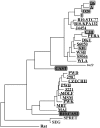Fine haplotype structure of a chromosome 17 region in the laboratory and wild mouse
- PMID: 18245833
- PMCID: PMC2278102
- DOI: 10.1534/genetics.107.082404
Fine haplotype structure of a chromosome 17 region in the laboratory and wild mouse
Abstract
Extensive linkage disequilibrium among classical laboratory strains represents an obstacle in the high-resolution haplotype mapping of mouse quantitative trait loci (QTL). To determine the potential of wild-derived mouse strains for fine QTL mapping, we constructed a haplotype map of a 250-kb region of the t-complex on chromosome 17 containing the Hybrid sterility 1 (Hst1) gene. We resequenced 33 loci from up to 80 chromosomes of five mouse (sub)species. Trans-species single-nucleotide polymorphisms (SNPs) were rare between Mus m. musculus (Mmmu) and Mus m. domesticus (Mmd). The haplotypes in Mmmu and Mmd differed and therefore strains from these subspecies should not be combined for haplotype-associated mapping. The haplotypes of t-chromosomes differed from all non-t Mmmu and Mmd haplotypes. Half of the SNPs and SN indels but only one of seven longer rearrangements found in classical laboratory strains were useful for haplotype mapping in the wild-derived M. m. domesticus. The largest Mmd haplotype block contained three genes of a highly conserved synteny. The lengths of the haplotype blocks deduced from 36 domesticus chromosomes were in tens of kilobases, suggesting that the wild-derived Mmd strains are suitable for fine interval-specific mapping.
Figures



Similar articles
-
Polymorphisms distinguishing different mouse species and t haplotypes.Genet Res. 1992 Aug;60(1):43-52. doi: 10.1017/s0016672300030652. Genet Res. 1992. PMID: 1452014
-
Subspecific origin and haplotype diversity in the laboratory mouse.Nat Genet. 2011 May 29;43(7):648-55. doi: 10.1038/ng.847. Nat Genet. 2011. PMID: 21623374 Free PMC article.
-
Polymorphism in hybrid male sterility in wild-derived Mus musculus musculus strains on proximal chromosome 17.Mamm Genome. 2009 Feb;20(2):83-91. doi: 10.1007/s00335-008-9164-3. Epub 2009 Jan 3. Mamm Genome. 2009. PMID: 19123034
-
Haplotype-based genetics in mice and rats.Trends Genet. 2005 Jun;21(6):318-22. doi: 10.1016/j.tig.2005.03.010. Trends Genet. 2005. PMID: 15922828 Review.
-
Haplotype analysis and identification of genes for a complex trait: examples from schizophrenia.Ann Med. 2004;36(5):322-31. doi: 10.1080/07853890410029824. Ann Med. 2004. PMID: 15478307 Review.
Cited by
-
Natural variation in the zinc-finger-encoding exon of Prdm9 affects hybrid sterility phenotypes in mice.Genetics. 2024 Mar 6;226(3):iyae004. doi: 10.1093/genetics/iyae004. Genetics. 2024. PMID: 38217871 Free PMC article.
-
X chromosome control of meiotic chromosome synapsis in mouse inter-subspecific hybrids.PLoS Genet. 2014 Feb 6;10(2):e1004088. doi: 10.1371/journal.pgen.1004088. eCollection 2014 Feb. PLoS Genet. 2014. PMID: 24516397 Free PMC article.
-
Accelerated evolution of the Prdm9 speciation gene across diverse metazoan taxa.PLoS Genet. 2009 Dec;5(12):e1000753. doi: 10.1371/journal.pgen.1000753. Epub 2009 Dec 4. PLoS Genet. 2009. PMID: 19997497 Free PMC article.
-
The phenotypic distribution of quantitative traits in a wild mouse F1 population.Mamm Genome. 2012 Apr;23(3-4):232-40. doi: 10.1007/s00335-011-9377-8. Epub 2011 Dec 3. Mamm Genome. 2012. PMID: 22138814
-
Prdm9 incompatibility controls oligospermia and delayed fertility but no selfish transmission in mouse intersubspecific hybrids.PLoS One. 2014 Apr 22;9(4):e95806. doi: 10.1371/journal.pone.0095806. eCollection 2014. PLoS One. 2014. PMID: 24756080 Free PMC article.
References
-
- Artzt, K., D. Barlow, W. F. Dove, K. Fischer-Lindahl, J. Klein et al., 1991. Mouse chromosome 17. Mamm. Genome 1 (Spec No): S280–S300. - PubMed
-
- Barrett, J. C., B. Fry, J. Maller and M. J. Daly, 2005. Haploview: analysis and visualization of LD and haplotype maps. Bioinformatics 21 263–265. - PubMed
-
- Barski, A., S. Cuddapah, K. Cui, T. Y. Roh, D. E. Schones et al., 2007. High-resolution profiling of histone methylations in the human genome. Cell 129 823–837. - PubMed
-
- Chistiakov, D. A., Y. A. Seryogin, R. I. Turakulov, K. V. Savost'anov, E. V. Titovich et al., 2005. Evaluation of IDDM8 susceptibility locus in a Russian simplex family data set. J. Autoimmun. 24 243–250. - PubMed
Publication types
MeSH terms
LinkOut - more resources
Full Text Sources
Molecular Biology Databases

